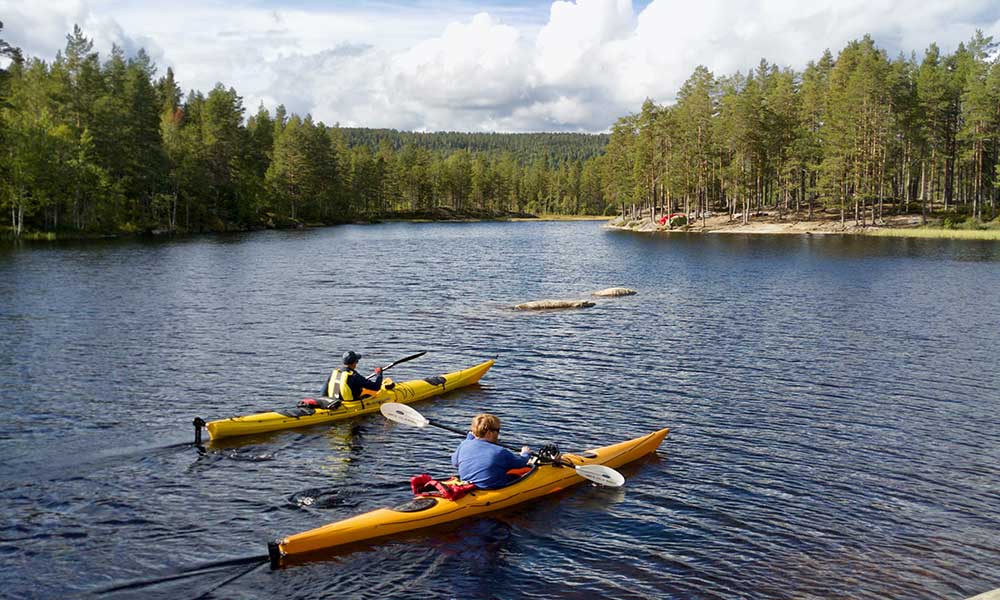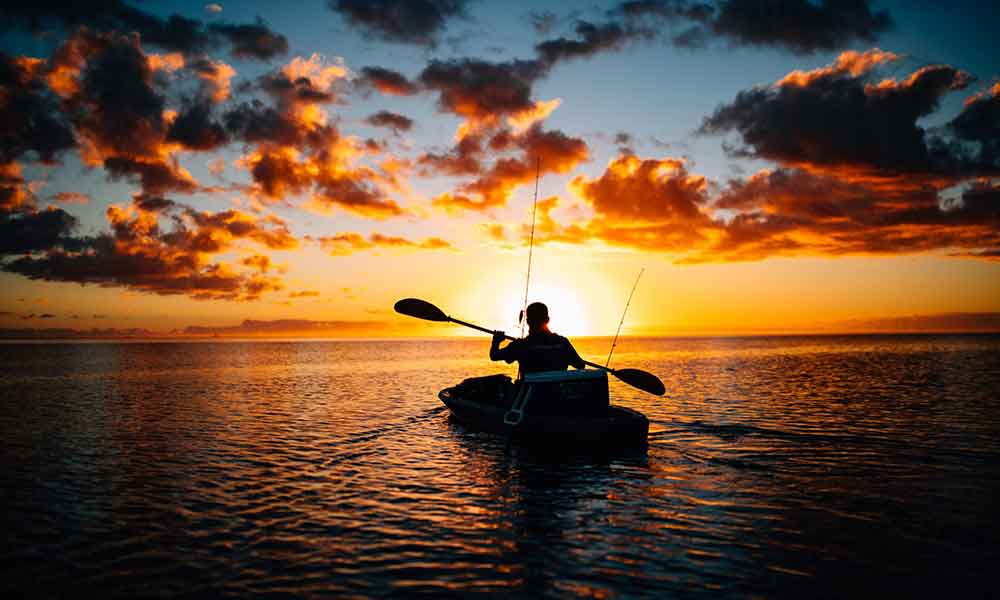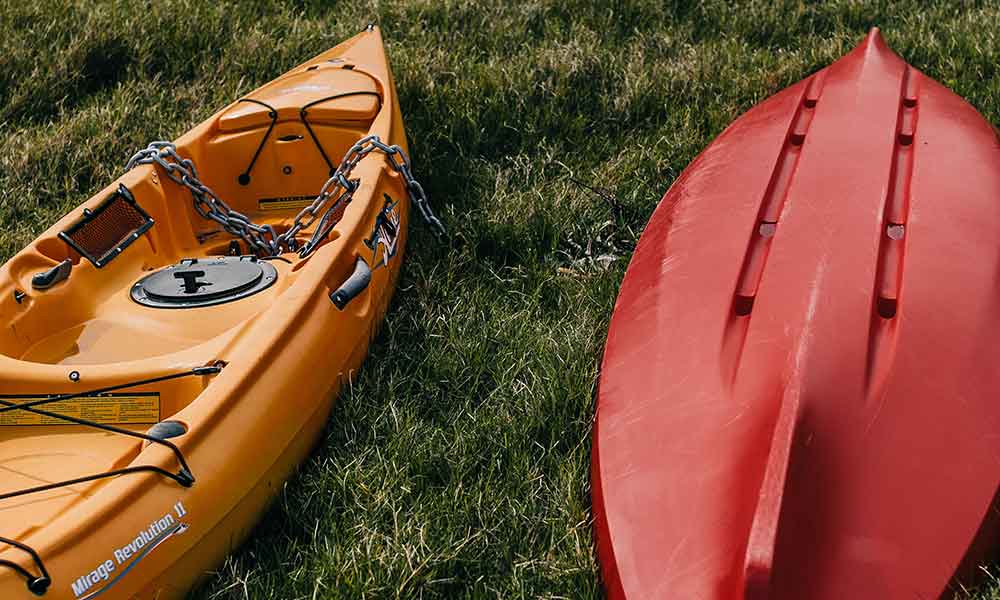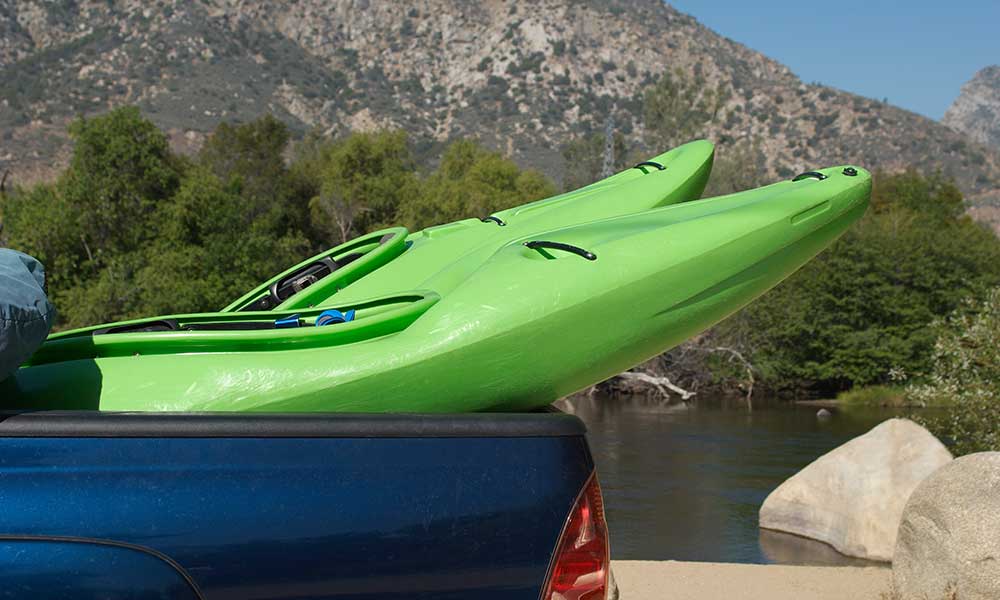Kayaks are designed with different purposes in mind, which has resulted in a variety of types, shapes, and sizes of kayaks available on the market. As a beginner, choosing a kayak from this wide range can be a daunting prospect. Our guide to the types of kayaks will help you to choose the right kayak for the type of kayaking activity you want to pursue.
Kayaks are divided into several categories based on their design and function. Sit-in and sit-on are two broad distinctions in design, while differences in function range from recreational, touring, fishing, whitewater, ocean, and racing kayaks. Each type of kayak has features geared to its function.
Kayaks made for different purposes have characteristics built into their design that makes them suitable for the intended purpose. Some are designed with stability in mind for the beginner kayaker, while others focus on racing features, whitewater kayaking, or fishing. Selecting the right kayak for your purpose and needs will ensure that your kayaking adventure is comfortable as well as tons of fun!
Types Of Kayaks By Design
Two main design distinctions in the kayak world are the sitting position of the kayaker while operating the kayak. These two distinctions in the sitting position of the kayak are sit-in and sit-on kayaks.
The sitting position differences offer various advantages for the kayaker, depending on the circumstances the kayak is used in.
We will look at these two design features as the first aspect of kayak types since the type of kayaking you are interested in will determine your sitting position choice.
Sit-On Kayaks
Sit-on kayaks are designed for the kayaker to sit on top of the kayak on what would be considered the kayak’s deck. This sitting position either has a seat fixed to the top of the deck, or the deck is molded to create a seat and footrests for the kayaker.
Sit-on kayak designs have many benefits, but there are also some disadvantages to sit-on kayaks in some kayaking conditions.
Advantages of the sit-on kayak include the following.
- Sit-on kayaks tend to be wider. This increases the kayak’s stability in the water and makes it easy for beginners to learn the art of paddling.
- They are sink-proof. Sit-on kayaks are sealed, which prevents water from entering the kayak if the kayak rolls over. Some sit-on kayaks have storage compartments, allowing water into the kayak if not closed properly.
- Sit-on kayaks are easier to climb aboard. Sit-on kayaks are easier to climb aboard both when starting from the bank or climbing aboard in the water after a rollover. This can be an important kayaking safety feature for beginners.
- Cooler in hot weather. Sitting on top of the kayak allows the kayaker to be cooled by the breeze coming off the water.
Sit-on kayaks have some good benefits, but there are also some negative aspects to the design that may be relevant to the type of kayaking you do or the conditions on the waters you will be kayaking.
The disadvantages of sit-on kayaks include the following.
- Exposure to inclement weather. Cold wind and rain can make for an unpleasant experience using a sit-on kayak where you are exposed to the elements. You are more likely to get wet and cold on a sit-on kayak than a sit-in kayak.
- Sun exposure. While some sunshine is good for everyone, over-exposure to the sun can be problematic, leading to sunburn and associated complications. The water usually intensifies the sun’s rays and thus the possibility of sunburn.
- Limited storage space. Some sit-on kayaks have limited storage compartments, while many have no storage options other than deck rigging.
- Not as stable in rough water. The higher sitting position is less stable in rough water conditions.
The most common applications where sit-on kayaks are used are recreational kayaks, fishing kayaks, surf kayaks, and some touring kayaks.
These kayaks designs are generally not suitable for whitewater river kayaking since they do not have the required volume for buoyancy.
Sit-In Kayaks
The sitting position on a sit-in kayak is below the kayak’s deck. A seat is positioned between the deck and the hull in a cockpit where the kayaker sits. The top edge of the cockpit usually comes up to the waist area of the kayaker. This means that the lower half of the kayaker’s body is inside the kayak.
This seating arrangement has some advantages and poses some challenges for kayakers. The main advantages of this design style for kayaks include the following.
- Protection from the weather. The ability to stay warm as well as dry can be a significant advantage when kayaking long distances or in cold conditions. This is usually achieved with a spray skirt over the cockpit.
- More storage space is available. Sit-in kayaks generally have a larger internal volume to accommodate the kayaker, so there is more space for storage.
- More stable in rough water. The lower center of gravity which results from the lower sitting position makes for greater stability of the kayak in rough water.
- Greater maneuverability. The design makes the kayak easier to control since you can use your body position to help maneuver the kayak.
- More comfortable over long distances. The lower sitting position is more comfortable for the kayaker for long-distance kayaking.
While the sit-in kayak offers great advantages for certain kayaking applications, the design also presents challenges that may be difficult for beginner kayakers.
Some of the challenges of sit-in kayaks include the following.
- Less stable on flat water. Sit-in kayaks are generally narrower, making them less stable for flatwater kayaking.
- A greater level of skill is needed. Sit-in kayaks are more difficult for beginners to master because of the difficulty in learning to balance the kayak and master paddling skills.
- Difficulty climbing aboard. It is more cumbersome to climb aboard a sit-in kayak at the bank and in open water.
- More prone to sinking. While sit-in kayaks have built-in buoyancy, the cockpit area can fill with water after a rollover, which can be almost impossible to empty in open water. This can cause the kayak to sink.
The types of kayaks that typically use the sit-in design include touring kayaks, racing kayaks, whitewater kayaks, sea kayaks, and even some recreational kayaks.
Kayaks By Purpose
Most kayaks are designed for a specific purpose and will have features built into the design that will increase the suitability of the kayak for those conditions.
It is wise to decide on the type of kayaking you will be participating in and then select the type of kayak that best fits those criteria. Many kayaks can be used for multiple kayaking disciplines, but some are only suitable for a single purpose. We will examine the different kayak types to give you the information needed to make this decision.
Recreational Kayaks
If your kayaking aspirations are purely recreational and leisure, then a recreational-style kayak is what you are looking for.
These kayaks are stable, easy to maneuver, and can often accommodate more than one person. They are easy to learn kayaking and can be used for other activities such as photography, where you need to have stability and control while performing other activities.
Fishing Kayaks
Fishing can be done from almost any type of kayak, but kayaks designed specifically for fishing offer many advantages.
They are designed for stability, even allowing the fisherman to stand up to cast or while fishing without the concern of tipping over. These kayaks have great storage options for gear and also offer the fitment of trolling motors or pedal motors so the fisherman can move the kayak around easily and have his hand free to do his fishing.
Touring Kayaks
Touring kayaks are built for the long haul. They are generally slender, narrow kayaks making it easier to paddle them through the water. Touring kayaks have good storage space, including waterproof compartments to keep your gear dry.
Touring kayaks can be sit-in or sit-on, but sit-in kayaks are generally preferred for longer distances due to the additional protection from the elements.
Tandem Kayaks
The enjoyment of outdoor activities is often enhanced by sharing them with someone else. Tandem kayaks offer this benefit since they are designed for two people.
Some tandem kayaks can be operated by one person, but others require two people to be aboard the kayak to function correctly, such as tandem racing kayaks.
Tandem kayaks can be any type of kayak designed for two people, and they can be sit-on or sit-in kayaks.
Pedaling Kayaks
If you have a back injury or shoulder issues, this is a brilliant option for you, as the only time you will need to use your arms is when you are getting the kayak in or out of the water.
Your legs also tend to tire much slower than your arms, and thus you can go much further distances in a pedaling kayak.
Pedaling kayaks are usually limited to only recreational kayaks and fishing kayaks.
Inflatable Whitewater Kayaks
This type of kayak is very different from the inflatable kayak intended for flat water, which would not do you much good here.
If you are adrenaline-seeking and want to start tackling whitewater, then this is a good place to start, as you will be able to head out onto the water with an inflatable whitewater kayak after completing a short course.
Another reason they are great, especially for newbies, is that they are very stable due to their greater width.
They are also very spacious and allow for comfort and a place for any gear you may wish to take with you. However, one downside with these kayaks is that they do not handle rivers with tight turns very well.
River Runners
These kayaks are also intended for whitewater and allow for a decent level of tracking when you go through long flat sections along a river, as they are usually between 7-8 feet long.
This also means though that they can manage tighter turns in the river. They are not the most comfortable kayaks for long distances, but they maximize enjoyment in whitewater!
Whitewater Kayaks
Whitewater kayaks are often called “plastics” since they are commonly made from a durable plastic material to handle the rigors of whitewater and rocks in rapids.
These kayaks are designed specifically for whitewater kayaking and are not suitable for other types of kayaking.
Sea Kayaks
Sea kayaks have a higher rocker, the curve extending from the bow to the stern, which aids them to crest waves and swells.
You will also find the front profile is a narrow V-shape, and this enables it to tackle rougher waters but makes it somewhat less stable.
Sea kayaks are easier to control than standard touring kayaks, and they track straighter. However, it must be noted that the design of this kayak means that it loses its advantages if placed in an alternative environment. They are less maneuverable on flat water and are less stable.
Diving Kayaks
Diving kayaks are a fun alternative to using an engine-powered boat to reach a diving spot. Although these are not exactly kayaks specifically designed for diving, the suitable ones are wide and stable and have large storage compartments. You can use either a sit-on or a sit-in kayak for this purpose.
As there are no specially designed kayaks for diving, those that work well for diving can typically be used for various other kayaking activities.
One such variation would be to use it as a recreational kayak as it is wide and offers large amounts of storage space. However, these kinds would not be ideal for touring.
Surf Kayaks
Ever wanted to combine the thrill of surfing with the delight of kayaking down a river? Well, that is where surf kayaks come in as they allow you to take on the surf from the comfort of a kayak.
Surf kayaks can be sit-in or sit-on kayaks. The surf kayak is brilliant for its designed purpose, which is the distinct combination between paddling and surfing.
However, due to its specialization and the overall design of the kayak, it is typically unsuitable for any other form of kayaking.
Sail Kayaks
Sail kayaking is a far less common type of kayaking; however, it has been around for a fairly long time. Although there are not typically kayaks specifically designed for sailing, you can get attachments for your existing kayak to help enhance its speed and take advantage of wind propulsion.
If you intend to attempt long distances in your kayak, adding a sail to your kayak would make a significant difference. Additionally, it ensures less physical strain is placed on the kayaker. This would be ideal for those who wish to do touring and sea kayaking.
It must be noted, though, that not all kayaks will be able to accommodate a sail. Even if they can have them fitted, some may become unbalanced by the sail, significantly reducing their usability.
The Construction Of The Kayak
There are different types of kayaks as far as the materials used to make them are concerned and how they are constructed.
Knowing more about these will help you choose which kayak material best suits your requirements. There are three main categories regarding kayak construction materials.
- hard-shell kayaks
- foldable kayaks
- inflatable kayaks
Each of these foundation construction types has subcategories of different construction materials as well. We will examine each type to give you a good idea of what’s available to make an informed choice for your kayak type.
Hard-Shell Kayaks
Hard-shell kayaks make up the largest category for the construction types of kayaks. However, there is a large variety in terms of designs, features, and material types in this kayak category. What they have in common is the rigid hull.
Some of the materials used in hard-shell kayaks include the following.
- Composite Materials. This material category is an umbrella term for various materials such as carbon fiber, fiberglass, and Aramid fiber. These types of kayaks are made up of layers of synthetic material that are bonded with resin. These kayaks are lightweight and incredibly responsive, but they can be quite expensive.
- Plastic. The most common kayak in this category is made from rotomolded polyethylene and is very common and the most inexpensive type you will come across. Whitewater kayaks are also made from plastics, but they are more expensive since they are built for more rugged conditions.
- Wood. This type of material will cost you quite a bit more than the other two options as they result from hand-craftsmanship and are not mass-produced. This type of kayak has a very traditional appearance and is lightweight and structurally reliant. However, wood kayaks are not as durable as the other materials and require more maintenance.
Foldable Kayaks
Foldable kayaks are also known as collapsible kayaks, and they are a happy medium between the hard-shell and inflatable kayak. Their frames are rigid, yet they can collapse. They are stiffer than inflatable kayaks but offer a portable convenience.
Their handling and general performance are better than inflatable kayaks, but they are not as efficient in the water as most hard-shell kayaks. Instead, they can be compared to touring hard-shells. You will find that they are generally less expensive than hard-shells but more expensive than inflatable kayaks.
One point worth noting is that foldable kayaks are not as durable as hard-shells, even though they offer a similar rigidity when unfolded. Still, they do certainly offer more durability than inflatable kayaks.
Inflatable Kayaks
Inflatable kayaks from years gone by were nowhere near as efficient as they are today, with some of them being decent contenders against hard-shells.
They have also grown in popularity, especially among recreational paddlers, and there are some which are even designed to take on whitewater.
Reasons why you may opt for an inflatable kayak over a hard-shell or even a foldable kayak include the fact that they are incredibly lightweight. They are also very portable and make for easy storing.
Inflatable kayaks make a more favorable option for heavier individuals as they are inherently more buoyant than hard-shell kayaks.
Although they have their advantages, these kayaks, made from PVC and synthetic rubbers, do not, unfortunately, offer the same level of performance as hard-shell kayaks. They are also less maneuverable and not as efficient as hard-shells and are likely to be an option for someone only interested in recreational kayaking or fishing kayaking.
Conclusion
More and more people are looking to get out into nature and explore the world, and one of the many activities worth enjoying is kayaking. The most important thing, though, is to ensure that you understand what types of kayaks are available and then decide which best suits your needs.
Consider your budget, where you will be storing it, and how you will transport it as well. Then assess why you want a kayak; if you want to spend leisurely time on flat water, then a recreational kayak is for you. If you desire the thrill of whitewater, then something like a river runner, whitewater kayak, or inflatable whitewater kayak is for you!







